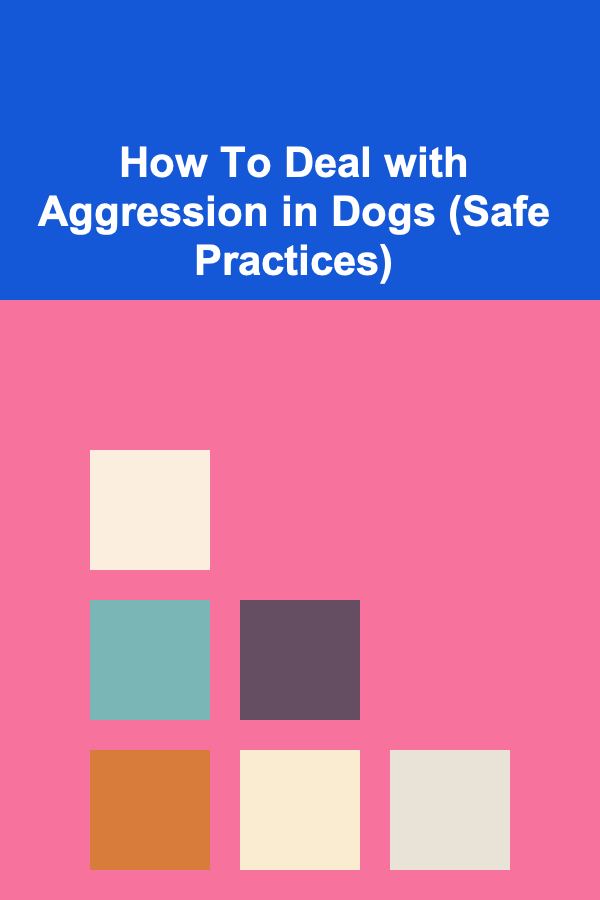
How To Deal with Aggression in Dogs (Safe Practices)
ebook include PDF & Audio bundle (Micro Guide)
$12.99$6.99
Limited Time Offer! Order within the next:

Dogs are often seen as friendly companions, but when aggression surfaces, it can be a serious concern. Aggression in dogs can manifest in various forms, from growling and snarling to biting and attacking. Understanding the root causes of aggression and knowing how to deal with it effectively is crucial for the safety of both the dog and its owner. In this article, we will explore safe and effective practices for managing aggression in dogs, addressing both the causes of aggressive behavior and methods for resolving it.
Understanding Aggression in Dogs
Before diving into how to manage aggression, it's important to understand what aggression in dogs entails. Dog aggression is any behavior that involves the dog exhibiting hostile actions toward another animal, person, or object. It often involves a threat, and can sometimes escalate to biting or attacking. Aggressive behaviors are usually driven by fear, frustration, anxiety, territorial instincts, or a lack of socialization.
There are different types of aggression in dogs, including:
1. Fear Aggression
Fear aggression is one of the most common causes of aggression in dogs. It occurs when a dog feels threatened and responds defensively by growling, snapping, or attacking. This type of aggression is often seen in dogs that were not properly socialized during their critical developmental periods.
2. Territorial Aggression
Dogs are naturally territorial animals, and they may become aggressive when they perceive a threat to their home or space. Territorial aggression may be triggered by unfamiliar people or animals approaching the dog's home, yard, or possessions.
3. Protective Aggression
Protective aggression occurs when a dog perceives a threat to their owner or family members. This type of aggression is common in breeds that have been specifically bred for guarding or protective roles, such as German Shepherds or Doberman Pinschers.
4. Redirected Aggression
Redirected aggression occurs when a dog cannot reach the source of its frustration and instead redirects its aggression onto another object or animal. For example, a dog may be angry at another dog, but if it is restrained or unable to reach it, the dog may turn and attack its owner or another animal nearby.
5. Social Aggression
Some dogs exhibit aggression due to poor socialization skills, especially around other dogs or people. This is common in puppies that were not properly exposed to various situations or environments. It can lead to issues with dominance and competition with other dogs.
6. Pain-Induced Aggression
Aggression due to pain is often linked to health issues or injuries that cause discomfort. A dog in pain may become more sensitive to touch and may react aggressively if it feels threatened or is touched in a painful area.
Identifying Aggressive Behavior in Dogs
Recognizing the signs of aggression early is crucial for intervention. Aggressive dogs usually exhibit specific body language that can indicate they are feeling threatened or anxious. Some common signs of aggression in dogs include:
- Growling or Snarling: This is often a warning sign that a dog feels threatened. It may precede an attack or bite.
- Baring Teeth: When a dog shows its teeth, it is often a sign of aggression or a threat.
- Raised Hackles: The fur along the dog's back may stand up when the dog is feeling aggressive or fearful.
- Stiff Body Language: An aggressive dog may appear tense and rigid.
- Lunging: A dog may lunge at an individual or another dog as a sign of aggression.
- Biting: Biting is often the final step in aggressive behavior, and it can be dangerous to humans and other animals.
Understanding these warning signs can help owners identify potential problems before they escalate. If your dog exhibits aggressive behavior, it's essential to take immediate action to prevent harm.
Safe Practices to Manage Aggression in Dogs
Managing aggression in dogs involves several steps, including prevention, training, and professional intervention. It's important to approach aggressive behavior carefully to ensure the safety of everyone involved. Here are some safe practices to help manage dog aggression:
1. Socialization and Early Training
Proper socialization is the key to preventing aggressive behavior in dogs. Early socialization helps dogs learn how to interact with other dogs, animals, and humans in a positive and non-threatening manner. Socialization should begin at an early age, ideally during the first 16 weeks of life, although adult dogs can also benefit from socialization.
Tips for Socialization:
- Expose puppies to a variety of environments, people, and other animals. This helps them become accustomed to different situations and reduces the likelihood of fear-based aggression.
- Use positive reinforcement. Reward dogs for calm behavior when interacting with others, so they learn that positive interactions are rewarding.
- Avoid overwhelming your dog. Gradually introduce new experiences and individuals to prevent stress and anxiety.
2. Training with Positive Reinforcement
Training your dog using positive reinforcement methods is one of the safest and most effective ways to address aggression. Positive reinforcement involves rewarding your dog for good behavior, which encourages them to repeat it.
Key Training Techniques:
- Redirect Aggressive Behavior: If your dog shows signs of aggression, redirect their attention to something positive, such as a toy or a treat. This helps them associate positive experiences with potentially stressful situations.
- Obedience Training: Teaching basic commands like "sit," "stay," and "leave it" can help you maintain control in tense situations. A well-trained dog is easier to manage and less likely to act aggressively.
- Desensitization: Gradually expose your dog to situations that trigger their aggression in a controlled and safe manner. Over time, this helps reduce their fear or frustration.
3. Avoid Punishment-Based Training
Punishment-based training, such as using shock collars or harsh verbal reprimands, can worsen aggression in dogs. Dogs that experience pain or fear may become more aggressive as a result of punishment. Instead, focus on positive reinforcement and rewards to encourage good behavior.
4. Manage Triggers
Identifying and managing triggers is essential in preventing aggression. If you know that certain situations or environments make your dog anxious or aggressive, it's important to avoid or minimize exposure to those triggers. Some triggers to be aware of include:
- Strangers approaching the home
- Other dogs or animals
- Loud noises or sudden movements
- Health issues or pain
If you can't avoid the triggers, try to control the situation by maintaining a calm and controlled environment. Keep your dog on a leash, create barriers, or remove them from the situation if necessary.
5. Proper Exercise and Mental Stimulation
Dogs that are bored or have excess energy may become more likely to act aggressively. Regular physical exercise and mental stimulation are crucial for reducing stress and frustration in dogs.
Exercise Tips:
- Daily Walks: Regular walks provide both physical exercise and mental stimulation. A tired dog is less likely to display aggression.
- Interactive Toys and Puzzles: Provide your dog with toys that stimulate their brain, such as puzzle feeders or chew toys, to keep them occupied and engaged.
- Playtime: Engage in play with your dog to help them burn off excess energy and build positive associations with their environment.
6. Consult a Professional Trainer or Behaviorist
If your dog's aggression persists or escalates despite your efforts, it may be time to consult a professional dog trainer or behaviorist. These professionals have the knowledge and experience to address complex behavioral issues in dogs. A certified trainer can assess your dog's behavior, create a tailored training plan, and guide you through safe techniques to manage aggression.
7. Veterinary Intervention
In some cases, aggression may be linked to underlying medical issues, such as pain, illness, or neurological conditions. A visit to the veterinarian is essential to rule out any medical causes of aggression. If your dog is found to be in pain or suffering from a medical condition, treatment may help alleviate the aggression.
8. Safety Measures for Aggressive Dogs
When dealing with an aggressive dog, safety is paramount. It's essential to take precautions to protect yourself, others, and your dog during training and behavior management.
- Use a Muzzle: If you're unsure of your dog's behavior or if you're working on desensitization, consider using a muzzle. A properly fitted muzzle can prevent biting while still allowing your dog to breathe and drink.
- Leash Control: Always keep your dog on a leash when in public or around potential triggers. A leash provides control and prevents your dog from attacking others.
- Avoid Unnecessary Stress: During training or behavior management, avoid overwhelming your dog with too many new experiences at once. Keep the environment calm and positive.
9. Dealing with Aggression in Specific Situations
Different types of aggression may require specific approaches. Here's how to deal with aggression in certain situations:
Aggression Towards Strangers
If your dog displays aggression towards strangers, it's important to gradually desensitize them to unfamiliar people. Start by having a friend or family member visit and provide treats to your dog. Over time, the dog will learn to associate strangers with positive experiences.
Aggression Towards Other Dogs
Aggression towards other dogs can often be managed through careful introductions, leash training, and controlled exposure. It's important to allow dogs to meet on neutral ground and not force interactions. If necessary, seek help from a professional to prevent fights from escalating.
Resource Guarding
Dogs that guard food, toys, or other possessions can be aggressive when they feel their resources are threatened. Training your dog to "leave it" or "drop it" in exchange for a higher-value reward can help reduce resource guarding behavior.
Conclusion
Aggression in dogs is a serious issue that requires careful attention and management. Understanding the causes of aggression, recognizing early warning signs, and implementing safe practices for training and behavior management are essential for addressing this challenge. Through proper socialization, positive reinforcement training, managing triggers, and seeking professional help when necessary, you can help your dog overcome aggressive behavior and live harmoniously with you and others. Safety should always be a priority, and by using these safe practices, you can ensure a positive and healthy relationship with your dog.

How to Keep Your Home Smelling Fresh with Simple DIY Tricks
Read More
How to Organize a Family Science Fair at Home
Read More
How to Soundproof Your Home Against Traffic Noise
Read More
How to Store Large Craft Projects in Progress
Read More
How to Store Seasonal Items Without Sacrificing Living Space
Read More
How to Store Your Wine Collection Without Taking Up Space
Read MoreOther Products

How to Keep Your Home Smelling Fresh with Simple DIY Tricks
Read More
How to Organize a Family Science Fair at Home
Read More
How to Soundproof Your Home Against Traffic Noise
Read More
How to Store Large Craft Projects in Progress
Read More
How to Store Seasonal Items Without Sacrificing Living Space
Read More